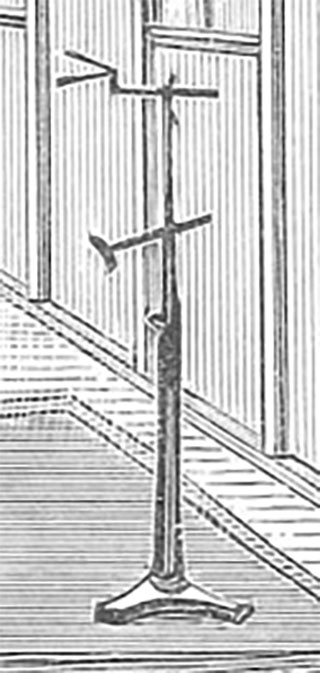Somehow the AI's difficulty with faces is less unnerving in 19th century engravings.
Yes, it's a Hiatal week, for reasons, and as usual I am determined to give you a full Bleat of things different from our usual concerns.
The things you find at archive.org when you don’t know what you’re really trying to find:
Portable houses! And with such endorsements, who can doubt their quality?
Your majesty’s attention to the portable house competition is keenly anticipated, and the whole world awaits your wise judgment
The seal of approval from the AMERICAN INSTITUTE. It is an INSTITUTE that is in AMERICA.
The houses were patented by George Ducker. But. Portable buildings - mostly used for field hospitals - were called “Doecker Huts.” Why? Ah:
Probably the most important firm in Germany, and certainly the most venerable, to be engaged at that time in the industrial production of wooden buildings was Christoph and Unmack A. G., of Niesky, in Silesia.
The history of the firm is complex and interesting. Like Schmidt of the Deutsche Werkstätten, Christian Ferdinand Christoph began his career as the maker of furniture, in partnership with an architect, Christian Rudolf Unmack. This was in Copenhagen, in 1869. Some time later, in 1880, the firm of Christoph and Unmack began to participate in the development of a system of construction of wooden barracks, invented many years previously by a Danish military officer, J. G. C. Doecker.
So it was Doecker over there, and Ducker here. What a coincidence! Unless this William B character made up his last name to sound like the Euro version.
Here’s how it comes to you. By horse. In flat packs.
It’s the IKEA of its day, except when you put it all together . . .
You have this.
Can’t be more than an afternoon’s work, eh?
That’s the Summer Cottage. Cost: $575 and up. Size: 18 X 20’
The appointments of the interior:
You had to bring furnishings, of course. What vacation would be complete without a Summer Desk?
The Lawn Pavilion.
Like the first one we saw, the interior looks a bit more capacious than the exterior illustration suggests. It doesn't quite match up, but there's no exterior illustration that matches.
Or people were very small.
A trysting window! Flirt from the comfort and safety of indoors.
The hunting lodge.
Dog not included.
The guy looks smashed. Well, they did pound a lot of cider and whiskey.
Do you know what this might be?
Correct. A photographer’s studio. And this?
 |
|
|
 |
|
I know what it is now, but I had to google 19th century photographer studio to look for the item.
It's a head-and-torso immobilizer assistant, so you sat still while the shutter was open. |
 |
|
|
Portable gym for all your midget cyclists:
A portable tennis-watching shelter:
How the other half lived.
A construction scene:
Thank you helpful burros! I guess you have to go up to get down.
Testimonial, in the florid prose of the day:
Wellfield, Strathmiglo, Fife, 21st July, 1888,
DUCKER PORTABLE HOUSE CO., Limited,
Nos. 30 and 37 St. Swithin's Lane, London, England.
GENTLEMEN:
The DUCKER HOUSE has proved a great success. No country house should be without one, it is so useful in many ways. In wet weather the children quite live in it, and play all day. I have gymnastic apparatus put up in it, swings, etc; the consequence is a quiet house, whilst the children are enjoying healthy exercise and games to their heart's content, where they disturb no one, and their tea-parties in the Ducker House are enjoyed by all.
As a painting-room it is also much appreciated, and the ladies spend much of their time in it during the hot, bright days, reading, painting, etc.
We have had much wet and stormy weather, but the house is as dry as a bone - not a drop of water has come in anywhere. It was put up in one day by the village joiner and my gamekeeper.
I find the Ducker House even more useful than I expected. Every one is delighted with it.
Yours very truly,
THE MASTER OF THE LINLITHGOW AND STIRLINGSHIRE HOUNDS.
The master of the Linlithgow Hounds! The Stiringshire ones, too.
We can walk down that lane today.
This week we'll follow another case that filled the papers in the Twenties. This time it's . . .
As soon as the story hit the paper, it seemed as if it would wane.
"The fever of the hunt seems to have been sapped from the investigators in two days of random searching, and tonight the attitude of the authorities smacked of in-difference."
By the 19th, it seems they’ve given up. The parents are discouraged:
Hold on a minute - Alice Corbett?
I've colorized the newspaper photo:
Hoo-boy:
Early on the morning of Friday, November 13, Jean M. Robeson, a fellow student and friend of Corbett, was found dead in her dormitory room as a result of accidental asphyxiation by illuminating gas. Later, at about 8 a.m., Corbett was observed leaving her room in the Clark House dormitory. When she failed to return later that afternoon, friends entered her quarters and discovered a note in Corbett's handwriting. College officials examined the note and reported that it contained the line “Mother, I am going home” and included content indicating that Corbett was in a “confused” state of mind. Corbett's father James showed the note to a physician who determined that she may have been suffering from mental illness at the time she disappeared.
Friday the 13th . . . was also the date Frances Smith vanished.
More tomorrow.
What will tomorrow bring? Who knows! All rules, cast to the wind! Propriety, physics, every rule! Cast windwise!
|